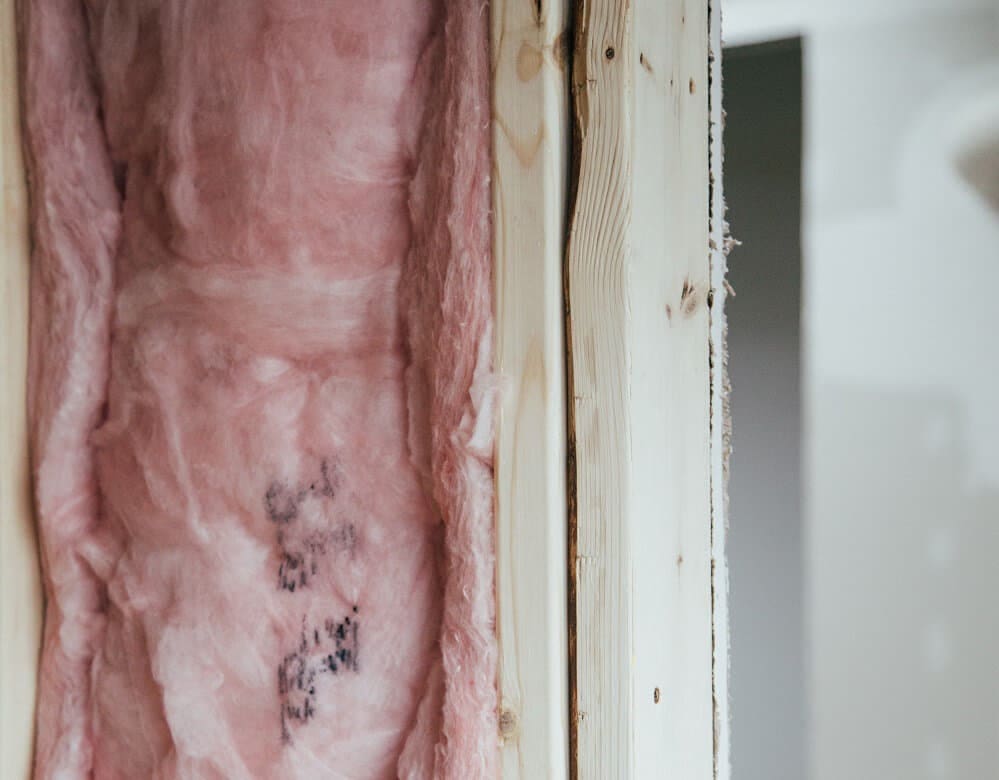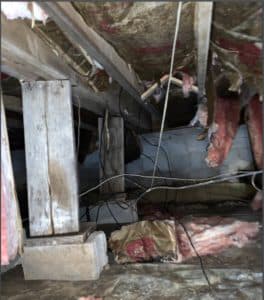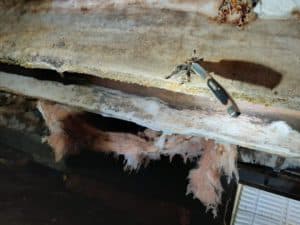How to Fix Sagging Crawl Space Insulation

Originally posted 4/3/19, revised by Kelly Kater 9/24/20
If you go into your crawl space, you’re likely to see a few things that make you uncomfortable. Many people have an aversion to snakes or spiders, and both of those are possible inhabitants in such a dark sheltered area. But I’ll bet you find something else you dislike, too: your fiberglass insulation is failing.
This is frustrating as well as gross. Fiberglass is notoriously itchy, but now it’s also dirty and probably wet. Worse yet, It’s a clear demonstration of money wasted: the insulation is not where you spent good money to install it, and it’s not doing its job. Insulation on the ground isn’t keeping your home insulated, which translates into higher utility bills.
Acculevel is a foundation and waterproofing company. We’ve been helping homeowners since our start in 1996, and have seen thousands of crawl spaces just like this. We know how damaging compromised fiberglass insulation can be. It’s not just wasting your money in utility costs- which is bad enough- but it’s also damaging your home’s flooring structure. Repairs to that structure can be exceptionally pricey, yet absolutely necessary to the stability of your home. We want to help you avoid this painful situation, if possible.
In this article, we’ll explain why fiberglass insulation is a terrible choice for a crawl space, how it should be replaced, and what signs indicate you need repairs to your floor’s wooden structure.
 This photo was taken by an Acculevel project manager at a free estimate appointment. This crawl space has a damaged vapor barrier, wet insulation, and a rotting flooring structure.
This photo was taken by an Acculevel project manager at a free estimate appointment. This crawl space has a damaged vapor barrier, wet insulation, and a rotting flooring structure.
Should I Remove Insulation from My Crawl Space?
Yes, if you have fiberglass insulation installed. At one point, builders considered fiberglass insulation an ideal solution, and it was the most commonly installed type of insulation. But time has shown us that this is not a good idea at all.
We’ve learned that fiberglass insulation is highly absorbent. Your crawl space may not have a water problem- but that won’t keep your insulation dry. Humidity alone can introduce enough moisture to make insulation damp. And once it gets damp, the problems start.
When installed, that insulation was squeezed tightly into place between wooden floor joists. Now, there’s damp material pressed up against the boards. When wood gets damp, it rots, and becomes an ideal home for termites. That combination is also a great breeding ground for mold.
Between mold and rot, your flooring structure is now compromised. And this is where your home’s stability, your family’s health, and your wallet all start to suffer.
 This photo (of the same crawl space) was taken by an Acculevel team member after repairs. The vapor barrier has been replaced, the fiberglass insulation removed, spray foam insulation installed, and the beams & support columns are repaired.
This photo (of the same crawl space) was taken by an Acculevel team member after repairs. The vapor barrier has been replaced, the fiberglass insulation removed, spray foam insulation installed, and the beams & support columns are repaired.
What do I do if I find issues when I remove the insulation?
Please Proceed with Caution!
If you choose to remove the fiberglass insulation yourself, make certain you protect yourself. The tiny fibers in the insulation will cause significant irritation if you get them on your skin, in your eyes, or in your lungs. You should wear long sleeves and pants, gloves, a mask, and goggles. (If you follow the link, it takes you to the NAIMA site that details needed precautions as well as instructions on how to properly dispose of the insulation itself.)
Mold
Once the insulation is gone, you’ll want to check all of the joists and beams for any signs of damage. Mold is fairly clear and obvious; if you’ve ever forgotten something in the refrigerator for too long, you know mold when you see it. Acculevel provides mold treatment, using high-quality products manufactured by Anabec, a manufacturer of premium cleaning chemicals.
Insect Damage
Insect damage can be more difficult to identify. You won’t usually see termites themselves, but if the wood is flaking or bubbling, this usually means the insects are tunneling underneath the surface. If you think you have termites or other insects, you’ll want to find a reputable exterminator for this. This is a service Acculevel doesn’t provide, but we have reviewed the topic and provided additional resources in this article.
 This photo was taken by an Acculevel project manager during a free estimate appointment. The insulation is falling, and there is extensive mold and rot on the joists.
This photo was taken by an Acculevel project manager during a free estimate appointment. The insulation is falling, and there is extensive mold and rot on the joists.
Structural Issues
If the beam shows signs of flaking or pitting, this suggests the wood has begun softening. This will lead to rot. If the board is damp or has mold, you should check the wood even if it’s not visibly damaged. The easiest way to do this is to use a screwdriver or pocketknife to poke at the wood. In the photo above, one of our project managers has used his knife to demonstrate that the wood is soft and easily flakes when the blade is pushed against the wood.
Damaged wooden components need to be repaired as soon as possible. The longer these repairs are put off, the worse the situation becomes. Replacing a few floor joists is far less expensive than installing a new center beam and supports. For more information about how these components are repaired or replaced, please review this article on sagging floor repairs and costs.
If you have more questions about waterproofing, sagging floor issues, or unpleasant odors in your crawl space, consult our comprehensive Crawl Space Repair Guide for Homeowners!
How Do You Keep Insulation from Falling?
Unfortunately, there is only way to prevent insulation sagging or falling in a crawl space: do not install fiberglass insulation. We recommend that you replace fiberglass insulation with a spray foam. This type of insulation adheres directly and permanently to whatever surface it’s sprayed on. It’s also water repellent, so it will not absorb moisture and cause the issues that fiberglass does. We have an article that explains how spray foam insulation works, what it costs, and what all of the benefits are.
Do You Need New Insulation in Your Crawlspace?
If you are willing and able to get into your crawl space, we have a DIY foundation inspection checklist that you can use to evaluate your home. We recommend that this be done twice a year, to catch any developing problems before they become significant issues. Minor repairs are always easier and less expensive to repair than major ones.
However, if you are one of the 16 million Americans who are claustrophobic, you can ask a qualified local contractor to evaluate your crawl space for you. Before you sign a contract for any service, please verify that the company is reputable, insured, and accredited by the Better Business Bureau.
Not sure what questions to ask, or what information you should acquire about the company you hire? Please use our guide to questions you should ask a contractor, with a free downloadable form.
If you live in Indiana or the surrounding states, contact Acculevel. We are a family-owned and operated company, and we provide free written estimates. One of our experienced project managers will evaluate your crawl space and recommend the best course of action for you, to keep your home strong and healthy for years to come.